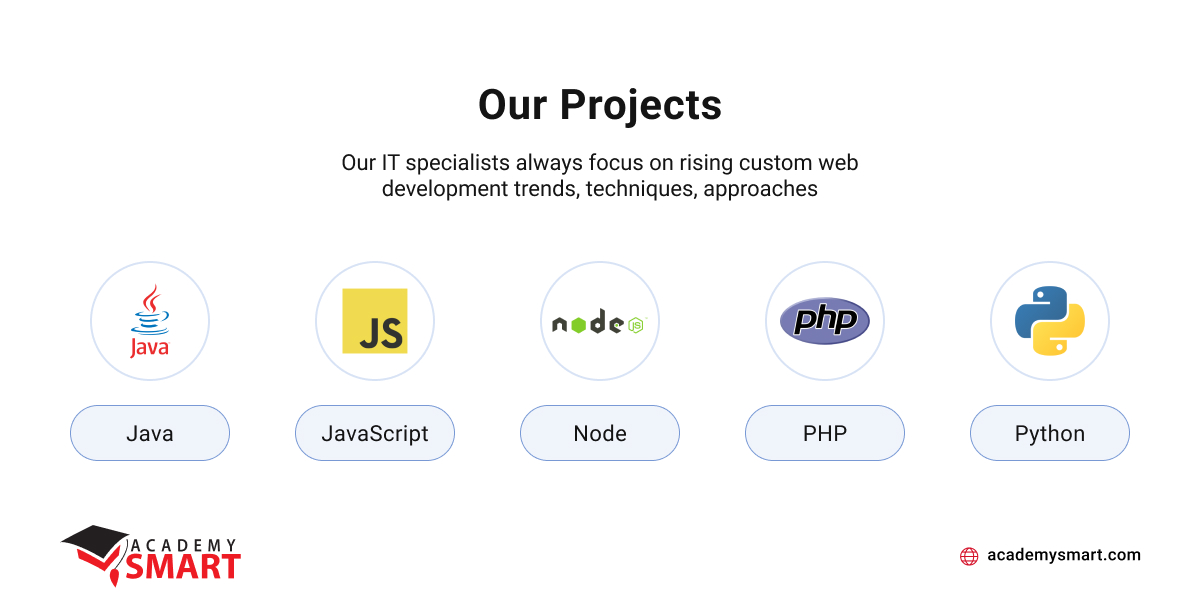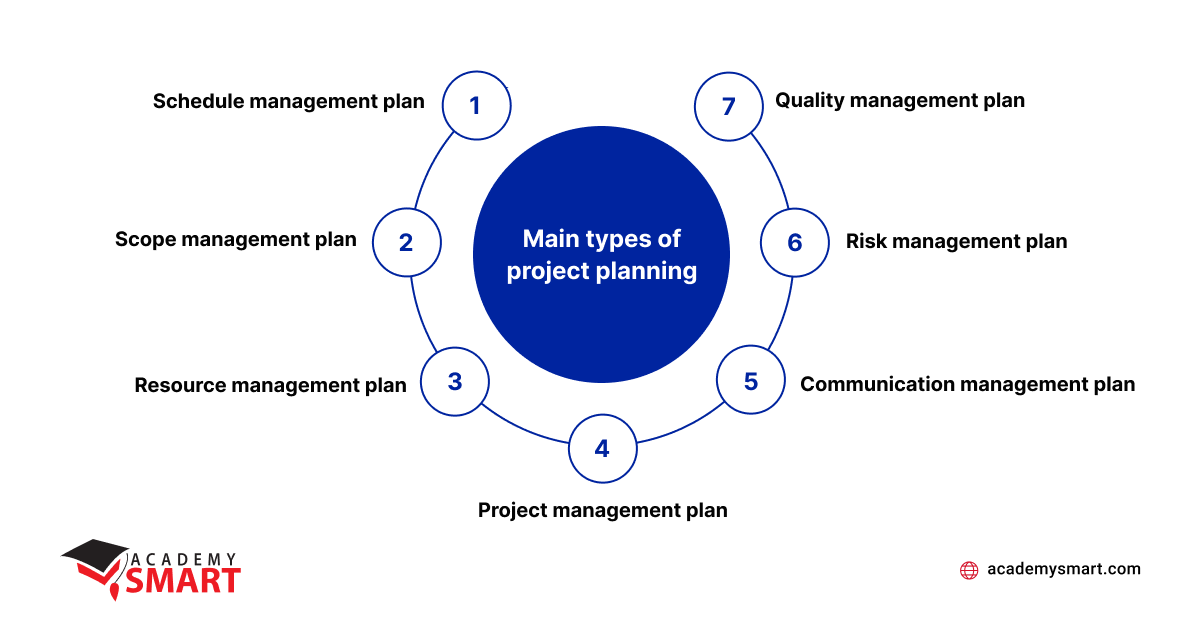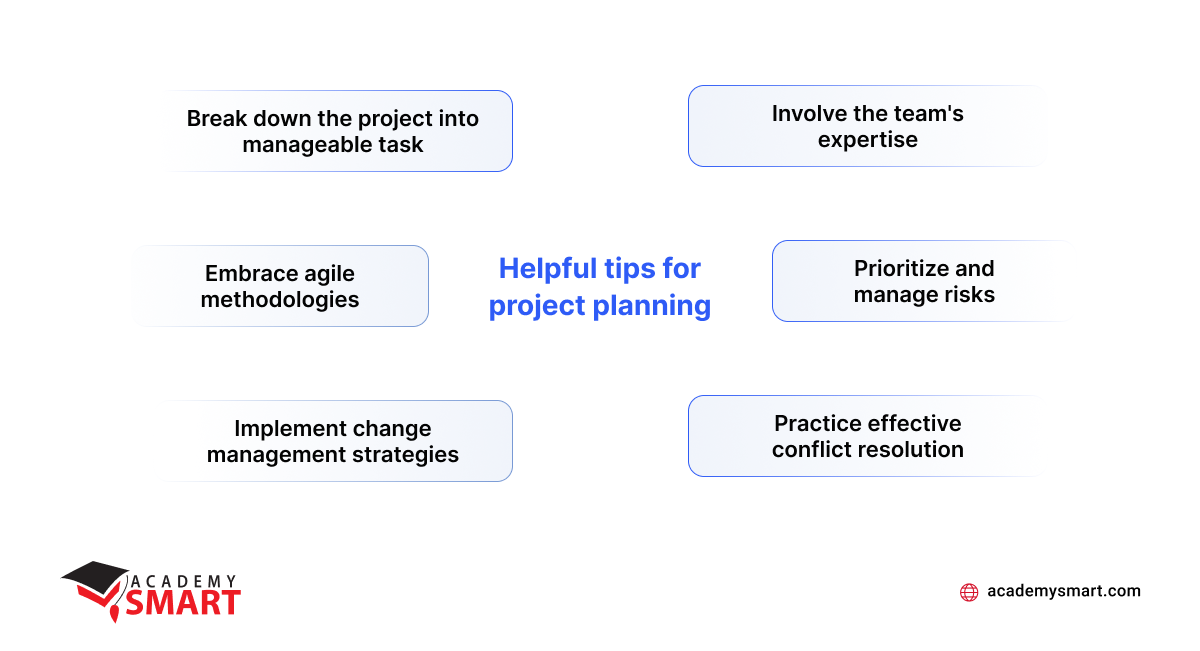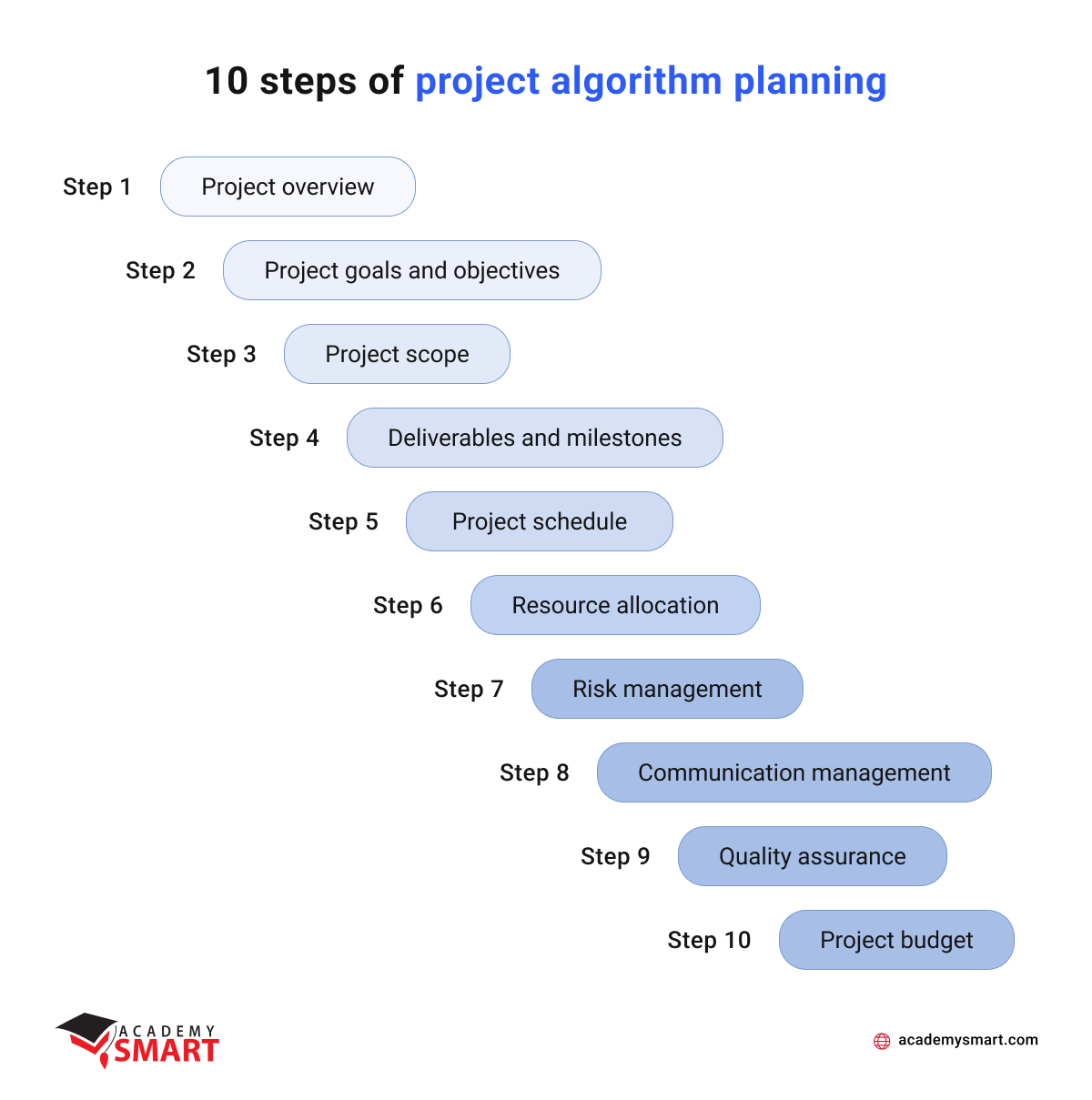
What is Project Planning and how to create an IT project plan in 10 steps with examples
Contents
The value that planning has is undeniable for businesses of any level. However, knowing and understanding the specificity of a plan is essential due to the product’s features. Of course, developing software applications requires complex efforts to transform an idea into cost-effective software qualitatively. This article takes a detailed look at the components of project planning for software applications, giving practical tips on how to use it wisely to ensure further development of this product type in the future.
What is Project Planning and why it is important
It is right to start creating software projects with a plan. What is project planning, and for what aims is it carried out?
The planning is defining project objectives, determining tasks and activities, and creating a roadmap for successful execution. It involves identifying project scope, deliverables, timelines, resources, risks, and communication channels. With input from stakeholders and the project team, the project manager is usually responsible for developing the project plan.
Software development project planning is essential for several purposes:
- Providing a clear project direction.
- Guiding project execution.
- Facilitating communication and coordination.
- Managing resources effectively.
- Mitigating risks.
- Ensuring stakeholders are aligned.
In software development, the project plan is crucial as it ensures alignment with customer needs, manages complex technical requirements, coordinates development efforts, tracks progress, and minimizes risks of project failure. On the Internet, you may get acquainted with various examples of project planning, but you should keep in mind the unique specifics of your project and utilize a third-party form, but not content.
The more detailed your software development plan is, the fewer surprises and obstacles your application will encounter when creating. Next, we will move on to a detailed discussion of practical issues, but in the meantime, visit our portfolio page to see how project plans are turning into reality for our clients.

Academy Smart portfolio
Different types of project planning
In software development, various types of project planning play a significant role in ensuring successful outcomes. These approaches encompass diverse aspects of the application-building lifecycle, such as managing scope, schedules, resources, risks, and quality.
Project management plan
The project management plan is a complex document that provides an overarching framework for effectively managing the processes from initiation to closure. It is a vital reference and roadmap for PMs, team members, and stakeholders, ensuring alignment and guiding project execution.
Project planning contains essential information and key elements for successful project delivery. It outlines the objectives, clearly defining the desired outcomes and measurable targets the team aims to achieve. It also describes the project’s scope, defining the boundaries and deliverables and any constraints or exclusions.
This document comprehensively identifies and analyzes project stakeholders, articulates a robust resources and risk management approach, and encompasses a communication strategy.
With a well-defined and articulated project management plan, development teams can align their efforts, minimize ambiguity, and proactively address challenges, ultimately increasing the likelihood of delivering the project within scope, schedule, and budget while meeting stakeholder expectations.
Scope management plan
The scope management plan is a crucial component of IT project planning that establishes a systematic approach to defining, validating, and controlling the project’s scope. It provides a structured framework that facilitates the successful completion of project deliverables within the defined boundaries while minimizing scope-related conflicts and misunderstandings. Utilizing it, the development team can proactively identify and manage scope-related risks, prevent scope creep, and focus on delivering the agreed-upon project outcomes.
The plan defines the mechanisms for scope validation, which involves obtaining formal acceptance from stakeholders that the results meet their requirements and expectations. It outlines the criteria and procedures for conducting scope reviews, acceptance testing, and obtaining sign-offs, ensuring the project’s outcomes align with stakeholder needs.
It also highlights project team members’ and stakeholders’ roles and responsibilities concerning scope management. It clearly defines who has the authority to make decisions regarding scope changes, who needs to be consulted, and who should be informed throughout the process. It promotes effective communication and collaboration, ensuring that decisions related to scope are made promptly and informed.
This planning type outlines the processes employed to manage changes to the project scope throughout its lifecycle effectively. It begins by clearly defining the project scope, including in- and out-of-scope elements. At last, the plan emphasizes scope control, providing guidelines on monitoring, evaluating, and approving scope change requests.
Schedule management plan
Schedule management planning establishes a structured approach to developing, monitoring, and controlling the project schedule. It serves as a roadmap for project execution and aids in tracking progress, managing timelines, and ensuring timely delivery of project deliverables. By adhering to it, project managers and developers can proactively manage project timeframes, identify potential delays or bottlenecks, and take appropriate corrective actions.
This plan includes guidelines for estimating task durations, considering factors such as historical data, expert judgment, and available resources. Estimation techniques, like analogous estimating, parametric estimating, or three-point estimating, help PMs allocate appropriate timeframes to individual tasks. It also defines the procedures for creating the project schedule, including using project management software and tools, such as Gantt charts or network diagrams, to visually represent task relationships, durations, and milestones. It helps enhance understanding and facilitate effective communication of the project schedule among stakeholders.
Of course, this planning type emphasizes the importance of monitoring and controlling the project schedule throughout its lifecycle. It gives the methodology of tracking progress, identifying schedule variances, and taking corrective actions when necessary. It may involve regular progress reporting, performance measurement techniques, earned value analysis, or schedule compression techniques like crashing or fast-tracking.
At last, the schedule management plan highlights the roles and responsibilities of team members in monitoring and controlling the project timelines. It clarifies who is responsible for updating the schedule, tracking progress, and sharing schedule-related information.
Resource management plan
The following key component of software development project planning provides a reliable framework for acquiring, allocating, and managing human resources and technology solutions. Our Top 10 Challenges article showed that it is one of the business’s most significant management issues. It ensures that the correct resources are available at the right time, in the needed quantities, and in suitable locations to support successful project delivery.
The resource management plan defines strategies for access required skills, expertise, and qualifications. It may involve various methods, such as hiring new personnel, outsourcing specific tasks, or utilizing existing resources within the organization. When making resource acquisition decisions, the plan also considers resource availability, cost-effectiveness, and project timelines. The plan also highlights the roles and responsibilities of team members in managing and reporting resource utilization and may incorporate HR training strategies.
It is equally important to fully pay attention to technical resources, which means the hardware, software, and infrastructure required to support the project’s technological needs. These resources are essential for the successful implementation and execution of technology-driven projects, such as enterprise software development.
The planning involves identifying the specific technology resources, such as servers, network equipment, software licenses, development tools, and testing environments. It should outline the processes for procuring and configuring them, ensuring scalability, compatibility, security, maintenance considerations, and specification compliance.
Of course, the resource management plan establishes mechanisms to monitor and measure resource utilization against planned allocations. Regular reporting on resource usage helps identify weak areas during the development lifecycle.
Risk management plan
The risk management planning begins by identifying potential risks that may arise during the project. It involves engaging stakeholders, developers, and subject matter experts to gather their insights and perspectives on potential troubles. This collaborative approach helps comprehensively identify risks affecting project objectives, deliverables, timelines, or budgets.
Then, the plan focuses on assessing their impact and likelihood. It needs to evaluate the potential consequences of risks on project objectives, such as schedule delays, budget overruns, quality issues, or stakeholder dissatisfaction. The likelihood of occurrence is also analyzed, considering historical data, expert judgment, and other relevant factors. By assessing impact and likelihood, project managers can prioritize risks and allocate resources appropriately for their prevention.
This planning type articulates strategies for managing and mitigating identified risks. It includes defining specific actions to respond to different risk scenarios. Depending on their nature and severity, they may include risk avoidance, risk transfer, risk mitigation, or risk acceptance strategies.
It is important to note that the risk management plan is a dynamic document that requires regular review and updates as the project progresses and new risks emerge. It establishes processes for ongoing risk monitoring and review. At last, the plan also addresses risk ownership, assigning responsible parties to implement risk response plans and monitor their effectiveness.
Quality management plan
The quality management plan brings the standards to which the software product should adhere, including functional and non-functional requirements, like performance, reliability, security, usability, and maintainability. These standards serve as benchmarks to assess whether the software application meets the desired level of quality.
In addition, this plan outlines the metrics and measurements that will be used to evaluate and track quality throughout the project. It usually includes KPIs related to defect density, code coverage, customer satisfaction, and other relevant quality indicators and establishes a system to monitor the progress of quality objectives.
The planning type incorporates quality assurance and quality control activities and defines the project team’s quality management roles and responsibilities. It encompasses testing, verification, and validation procedures to identify and rectify quality issues and outlines mechanisms for collecting feedback, lessons learned, and post-implementation reviews to see areas for improvement.
Communication management plan
This type provides a framework for planning, executing, and monitoring project communication to ensure that relevant information is shared, stakeholders are informed, and project objectives are achieved. It starts with defining the individuals and groups with an interest or influence in the project. It includes analyzing their needs, expectations, and preferred methods of communication. That enables PMs to effectively tailor the communication approach to meet stakeholder requirements.
The plan defines the appropriate channels, such as meetings, emails, project management software, collaboration tools, or formal documentation, based on the nature of the information and the stakeholder preferences. Then, it establishes the frequency and timing of project communication. It contains the schedule for regular status updates, progress reports, team meetings, and stakeholder meetings and outlines any specific milestones or events that may require additional communication or formal reporting.
Furthermore, the plan articulates the formats and templates for different communication types. It provides guidelines for creating reports, presentations, meeting agendas, minutes, and other relevant communication artifacts. It also clarifies who is responsible for initiating, preparing, reviewing, and delivering communication materials to promote effective coordination among team members.
The plan also addresses two-way communication. This document includes mechanisms for soliciting feedback, conducting surveys, and engaging stakeholders in dialogue to foster an open communication environment and facilitate early identification and resolution of potential issues or concerns. An essential part of that plan is a conflict resolution strategy. It may involve establishing a transparent conflict escalation and resolution process, promoting open and respectful communication.

Main types of project planning
Tips for project planning
You already have enough knowledge to start planning your app development at this stage. But before we give you some practical advice on making this process more efficient, accept the most important one: no plan works without a team. Bringing an idea to life requires people who know the technology and can use it wisely. If you have even the slightest doubt about the competence of the current crew, be sure to include the transition to another IT provider in your project planning example on time.
Tip 1. Embrace agile methodologies
Consider adopting Agile methodologies and tools, such as Scrum or Kanban, for software development project planning. Implement iterative and incremental development approaches to enhance flexibility and adaptability. Emphasize collaboration, regular feedback, and continuous improvement within the project team. By adopting these principles, project managers can navigate the complexities of app building projects more effectively, adapting to changing requirements, fostering collaboration, receiving timely feedback, and promoting continuous improvement.
Tip 2. Break down the project into manageable tasks
Divide the project into smaller, manageable tasks and subtasks. Ensure each task is specific, measurable, achievable, relevant, and time-bound (SMART). Use a work breakdown structure (WBS) to organize and structure the tasks hierarchically. That will help make the sequence of project creation stages clear, orderly, and understandable.
Tip 3. Implement change management strategies
Recognize that change is inevitable and have a change management strategy in place. Try to anticipate potential shifts and assess their impact on the project plan and involved parties. Be bold and proactively manage change by communicating effectively, engaging stakeholders, and minimizing disruption.
Tip 4. Prioritize and manage risks
Identify potential risks and uncertainties that may impact project success. Prioritize them based on their likelihood and impact and develop mitigation strategies. Regularly review and update the risk management plan as new or existing risks emerge.
Tip 5. Practice effective conflict resolution
Develop strong conflict resolution skills to address disagreements and conflicts within the project team. Encourage open and honest communication, active listening, and empathy. Seek win-win solutions that balance the needs of individuals with the actual objectives.
Tip 6. Involve the project team
Collaborate with your project team members to gather their input and consider their expertise in your IT project planning. With the help of this valuable information, which only experts have, you can get critical insights into the implicit prospects, hidden opportunities, and potential threats to the successful completion of the project.

Helpful tips for project planning
How to plan a project: 10 steps
And now, let’s briefly repeat the above and go through the guide on how to make project planning for creating a software application. It is essential to understand that each software product is unique, and particular tasks vary significantly from project to project. However, the points below are versatile and suitable for app development planning of almost any size and complexity.
Step 1. Project overview
Begin by providing an overview of the project’s purpose, scope, objectives, deliverables, and major milestones. Clearly state the business need or problem the application aims to resolve. Define the project’s stakeholders and identify their roles and responsibilities.
Keep in mind that this part of the planning document is typically considered a constant preview of the project. However, it is common for project managers to revisit and refine it throughout the project lifecycle. That’s why it’s critical to balance making necessary updates and maintaining its stability. Frequent and unnecessary changes to the project overview can create confusion and undermine development progress. Therefore, any modifications should be considered carefully by all relevant stakeholders.
Step 2. Project goals and objectives
In this step, the PM translates the initial product vision into a specific sequence of actions and deliverables. So, you have to define the specific goals and objectives the project aims to achieve. There are far-reaching implications behind this trivial phrase, so you should approach understanding the product’s vision with all caution.
On the one hand, it is imperative to initially imagine the development prospects of the product since the software is critically dependent on the technical features of the architecture on which it will be deployed, the technology stack with which it will be developed, and the specifics of the user experience that its audience expects. Important decisions such as the choice of monolithic, microservice, or serverless architecture, database types, and back-end and front-end technologies should be worked out in detail here, given the limitations that their choice may entail in the foreseeable future.
Similarly, it is impossible to fully formulate business goals without knowing your target audience, their needs, and the likely requirements for your product. If you expect to see certain features in your application one day, your plan should reflect the ability to be implemented already in the MVP. If you expect an explosion in the number of users and your services, consider the ability to scale the application already at this stage of software development project planning. Even if you consider the transition from a b2c to b2b model as a distant prospect, it should be clearly declared in the plan, at least as a low-priority objection. It is essential to understand and follow the principle that everything not considered in the plan will require extensive additional resources and efforts to implement it without a 100% guarantee of success.
On the other hand, it is impossible to take into account everything, but it is possible to exclude all unnecessary things. It is crucial to boldly dismiss useless functionality and abandon obsolete and unpromising technologies or fashionable features that are in no way connected with the project’s aims. At last, ensure the goals are measurable, realistic, and aligned with your business strategy.
Step 3. Project scope
The project scope involves clearly defining the project’s boundaries by outlining what is included and excluded. It establishes the specific deliverables and features to be developed while also considering any constraints, assumptions, or dependencies that may impact the project. This phase identifies the need for proof-of-concept work and clearly defines the functional scope of prototypes, minimum viable product, and further software releases.
Defining the scope helps manage stakeholder expectations and prevents scope creep. It acts as a reference point throughout the project, keeping the team focused on delivering the agreed-upon scope. Regularly reviewing and reassessing the scope allows for the timely identification and management of any deviations or potential changes.
Step 4. Deliverables and milestones
In this step, project managers identify the key deliverables and milestones that mark significant progress or achievements throughout the planning development lifecycle.
Deliverables are tangible outcomes that need to be produced, such as software modules, documentation, releases, or user guides. They are defined based on the project’s goals and specification. Milestones, on the other hand, are specific points in time that represent significant progress or the completion of a key deliverable. They serve as markers to track project progress and provide a sense of achievement. Milestones can be tied to specific events, such as the completion of a prototype, successful testing phase, or client sign-off.
By clearly defining deliverables and milestones, PMs establish a roadmap for the project, providing a clear sense of direction and progress tracking. Moreover, deliverables and milestones also serve as communication tools, enabling effective reporting and transparency to stakeholders, sponsors, and team members. They provide a shared understanding of project progress, help manage expectations, and facilitate collaboration and decision-making.
Step 5. Project schedule
The project schedule is developed to outline the timeline and sequence of activities required to complete the project. It specifies each task’s start and end dates, dependencies, and critical path analysis. It serves as a roadmap for project execution and helps manage resources effectively.
Creating the project schedule involves:
- breaking down the project into smaller tasks;
- estimating their durations;
- determining the order of their execution.
Dependencies between tasks are identified to ensure activities are scheduled most logically and efficiently. The critical path analysis identifies the longest sequence of dependent tasks, helping to find potential bottlenecks and areas of focus.
Regular monitoring and updating of the project schedule are essential to ensure accuracy and reflect any changes in project circumstances, adjusting task durations, updating dependencies, and incorporating new tasks or priority changes.
Step 6. Resource allocation
In essence, how to planning a project actually means strategically allocating available resources, which commonly are development budget, expertise, and technology. Each implies particular possibilities and limits within which certain success can be achieved. The art of PM is to attract the needed resources at the right time, to use the strengths of the available resources, and to prevent misuse.
Regular monitoring and resource allocation adjustment are important throughout the lifecycle to accommodate project requirements, timelines, or resource availability changes. This flexibility allows project managers to adjust resources to maintain project efficiency and productivity.
Step 7. Risk management
Here PMs focus on identifying, analyzing, and managing risks that may impact the project’s objectives, such as cost, schedule, quality, or scope. They assess potential threats and opportunities, develop mitigation strategies, and monitor risks throughout the project lifecycle, which may involve implementing contingency plans, adopting preventive measures, or transferring risks to third parties.
Risk analysis helps prioritize them based on probability and severity, allowing project managers to allocate appropriate resources for their reduction. Regular monitoring and reassessment of risks help ensure that mitigation plans remain effective and responsive to evolving software development conditions.
Risk management also includes proactive communication and stakeholder collaboration to address concerns, gather input, and obtain buy-in on risk minimization efforts.
Step 8. Communication management
That planning aims to promote clear and timely communication among development team members, stakeholders, and other relevant parties. It involves creating a specific plan that outlines communication objectives, roles and responsibilities, and the flow of information within the project.
It also includes strategies for addressing potential communication challenges or conflicts during the project. Another area of focus is acceptable and reliable channels for communication and sharing of documentation and other project-related information. Equally important is a strict schedule for regular appointments and flexibility in managing the timing of unscheduled meetings.
Step 9. Quality assurance
It’s crucial to ensure that the software product meets the desired level of quality. So, one of the most responsible tasks is defining standards and KPIs that will be used to assess and control the quality throughout the project. It establishes processes for quality assurance, such as conducting reviews, inspections, and tests.
Additionally, the plan defines roles and responsibilities, specifying who is accountable for implementing quality control measures. Regular monitoring and evaluation of the quality management plan help track the project’s adherence to quality standards and identify areas for improvement needed.
Step 10. Project budget
The final task that generalizes the decisions of the previous project planning steps is estimating and allocating resources, costs, and expenses required for project execution within the current budget.
Budget planning includes identifying the necessary financial resources, such as personnel, hardware and software expenses, external services, and other project-related expenditures. It involves estimating the costs associated with each project task and deliverable. Additionally, project managers consider any budget constraints, limitations, or financial guidelines the organization provides. They aim to ensure that the project is completed within the approved budget while meeting the desired project objectives.
Budget planning also includes monitoring and tracking project expenditures throughout the development lifecycle. It helps identify budget deviations, allows timely adjustments, and enables effective financial control.

Project planning algorithm
How Academy SMART can help you with project planning
For over 13 years, our IT agency has provided staff augmentation and complex software development services for business. We invite you to use the experience of our developers and project managers to optimize your workflows and create high-quality software.
Our experts will help you with the following:
- evaluating the project specification and creating a plan for its implementation;
- choosing of the optimal technology stack and infrastructure solution;
- creating clean, reliable, and secure code utilizing modern programming languages and frameworks;
- finding and hiring remote IT outstaffers with the necessary qualifications;
- selection of effective dedicated development teams;
- creation of turnkey enterprise software applications.
Cooperation with us will benefit you, leave a request to discuss the details.
Project Planning: Frequently Asked Questions
Is Project Planning the same as Project Management?
No, project planning is a component of project management. Project planning involves defining project objectives, scope, tasks, and timelines, while project management encompasses initiating, planning, executing, controlling, and closing a project to achieve its goals.
Who makes the Project Plan?
The project manager typically develops it.
Book a free consultation

Reach out to start talking today!











